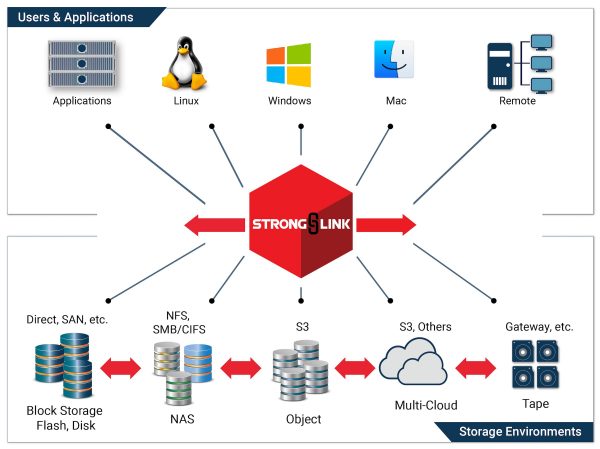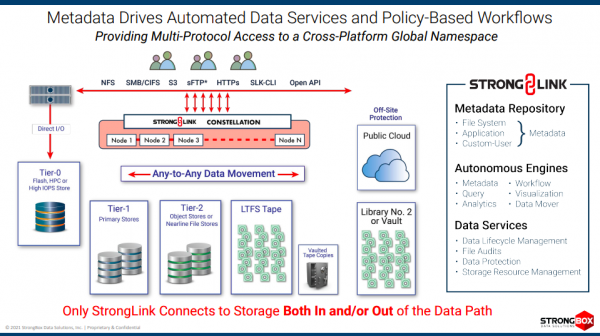StrongBox Simplifies Data Management With New Levels of Automation and Performance
Third gen software increases data usability by cost-effectively eliminating data silos at scale
This is a Press Release edited by StorageNewsletter.com on July 15, 2021 at 2:03 pmStrongBox Data Solutions, Inc. (SBDS) announced the StrongLink 3.2, delivering increased levels of automation and performance to radically simplify data management.
The combination of StrongLink’s foundational capabilities and new 3.2 software enhancements offers IT managers and channel partners a vendor-neutral solution to data and multi-vendor storage resource management with scalability to accommodate any sized environment. It also provides predictable pricing based on required performance, not capacity, so costs do not increase as data volumes grow.
“StrongLink’s new metadata-driven tools provide our researchers with maximum efficiency for data access and management across a large heterogeneous storage environment,” said Carsten Schmitt, storage administrator at Deutsches Klimarechenzentrum GmbH (DKRZ). “StrongLink provides researchers with global access to their data with workflows they are accustomed to but in an open-standards-based architecture that eliminates proprietary vendor lock-in. This is a key requirement for building the exabyte data archive system and minimizes the time needed to find or manage data across multiple classes of storage. The SBDS solution is helping DKRZ create a better environment to advance the state of the art of climate research.”
As data volumes grow at increasing rates, organizations are challenged to manage growing volumes of unstructured data across multiple storage silos while ensuring immediate data accessibility. StrongLink’s data-centric approach provides improved performance and administrator tools for better data management across vendor silos.
“Storage vendors are focused on keeping the data on their storage systems throughout its lifecycle. And although it appears to provide customers greater data lifecycle simplicity, it actually increases complexity and costly vendor lock-in because of storage silos,” said Marc Staimer, president, Dragon Slayer Consulting. “StrongLink is vendor and storage system-neutral. It enables customers to implement multi-vendor storage systems and new storage technologies transparently. With its increased automation, AI-ML, and disruptive non-capacity licensing, StrongLink provides customers the ideal cost-effective and high- performance data management system.”

Automation, Insights and Performance for Smart, Cost-Efficient Data Management
The SBDS third-generation intelligent software solution, StrongLink 3.2, gives customers insights into their data and storage throughout the entire data lifecycle.
It includes the tools to automate intelligent policy-based file actions across otherwise incompatible storage types, including flash, disk, cloud, and tape from any vendor – eliminating data silos and increasing data access. New features and capabilities include:
- StrongLink Galaxy with Multi-Site Replication for Increased Data Protection
Galaxy provides bi-directional multi-site replication for DR, collaboration, data protection and more, ensuring customer data is secure, protected and easily accessible wherever it is located. Metadata records replicate instantly across all sites as changes occur, and all or subsets of data are replicated asynchronously to maintain up to-the-second data copies. - Scalable Search Engine for Large Enterprises and Complex Queries
StrongLink’s third-gen query engine enables customers to keep pace with future growth by providing expanded scale to support large enterprises and complex queries across many billions of files. It also provides increased performance for queries that span multiple metadata types. - Enhanced Reporting Engine and Notification Capabilities
The new StrongLink reporting engine allows for multiple report categories and the creation of new reports to rapidly accommodate customer requests. The software also provides an enhanced notification system that monitors an expanded set of metrics, internal processes and network behaviors to provide fast, proactive alerts for system administrators. - New Access and Query Options to Support HPC and Research Environments
StrongLink CLI, a new command-line interface, accommodates HPC and other workflows that typically utilize scripted procedures. It allows for creating and annotating datasets with custom metadata tags, complex queries, workflow triggers, and more. The new CLI is in addition to the full-featured StrongLink web-based control panel application and the open API to give admins and users a complete selection of access utilities to better manage their data environment. - Added Support for Scientific Workflows
StrongLink now supports the NetCDF metadata standard for HPC and scientific workflows to provide researchers with more query options to rapidly locate files.
“The traditional data management paradigm relies on specialized storage solutions for the various stages of the data lifecycle, increasing the occurrence of data silos, vendor lock and system complexity,” said Floyd Christofferson, CEO. “StrongLink 3.2 brings an automated, data-centric approach to vendor-neutral storage resource management. It provides customers with crucial data intelligence plus the tools to operate across otherwise incompatible storage types from any vendor at scale.”
StrongLink provides IT staff control over their entire data environment with tools to manage file copies and data placement transparently based on data intelligence. It is for organizations managing growing volumes of unstructured data and is used by customers across a range of industries, including HPC and research, and for a variety of use cases such as BC/DR, active archive, automated data migration, storage tiering and non-disruptive technology refreshes.
The StrongLink 3.2 software is available.
Comments
StrongBox continues to penetrate the market with a comprehensive unstructured data management solution that spans all flavors of storage i.e file servers, object storage and tape supporting a range of access methods.
It has some pretty unique characteristics that bring to users some interesting behaviors and capabilities such global namespace and access to distributed data, migration, tiering with intelligent data placement across data servers and storage entities coupled with a global indexation that feed analytics and QoS.
Among various technologies developed by the StrongBox engineering team, we find interesting to cover 3FS, a tailored file system for transient data. This layer is used when StrongBox engine requires to cache data, as a landing zone during migrations processes, when tape is involved for example or for packing data when small files are managed.
It was developed in addition to the metadata engine and significantly reduces latency and justifies the choice made by the team to avoid other file systems like XFS or ZFS as it would create again a new metadata layer. 3FS leverages also the load-balanced and scale-out architecture of the StrongBox engine within a constellation. The other consideration is based on the required support of POSIX and SMB semantics as the global namespace spans POSIX, SMB and S3. This approach also prevents some potential issues in some characters encoding schemes.
3FS is optional but deploying it especially in large environment gives better response, experience and fluidity.
However, the company still suffers from a lack of visibility, being visible from large projects despite a rich features set solution. Addressing large configurations, only a fraction of the market can address represents a challenge for the team as long sales cycle can impact the bottom line of the company even with strong support from financial organizations.
One of the development angle could be to sign some reseller or OEM agreements as they have with Fujifilm.
The other side effect of this strategy is the potential danger it exposes the company to as a small innovative player. In other words, prospects and clients can argue about their dependency of such critical solution based on a small company that could disappear. And this is the case for many data management companies playing in that domain. It means that users don't have really alternatives and accept that risk as they don't find similar solutions from big players.

We identify several fundamental data management aspects and requirements for such projects. Among them, we can list replication, tiering and HSM with some innovative data mover techniques, analytics, content search and indexing, data classification, cloud and tape integration, access control and sharing capabilities or global namespace and multi-sites federation.
Here is the list of the usual suspects in that domain: Aparavi, Arcitecta, Arxscan, Atempo, BridgeStor, Cohesity, Congruity360 with Seven10, CTera Networks, Data Dynamics, Datadobi, DataGlobal, DBM Cloud, Druva, Fujifilm, Grau Data, DMF by HPE (SGI), Hammerspace, HPSS, iRODS, Komprise, Moonwalk, Nasuni, Nodeum, NTP, Panzura, Point Software, Quest, QStar, Rubrik with Igneous, Spectra Logic, Stealthbits, StrongBox, Tiger Technology, Varonis, Versity and XenData in addition to classic gorillas such Commvault, Dell, Hitachi Vantara, IBM, NetApp, Quantum, Veeam and Veritas. We noticed that InfiniteIO disappeared recently from this list.














 Subscribe to our free daily newsletter
Subscribe to our free daily newsletter

